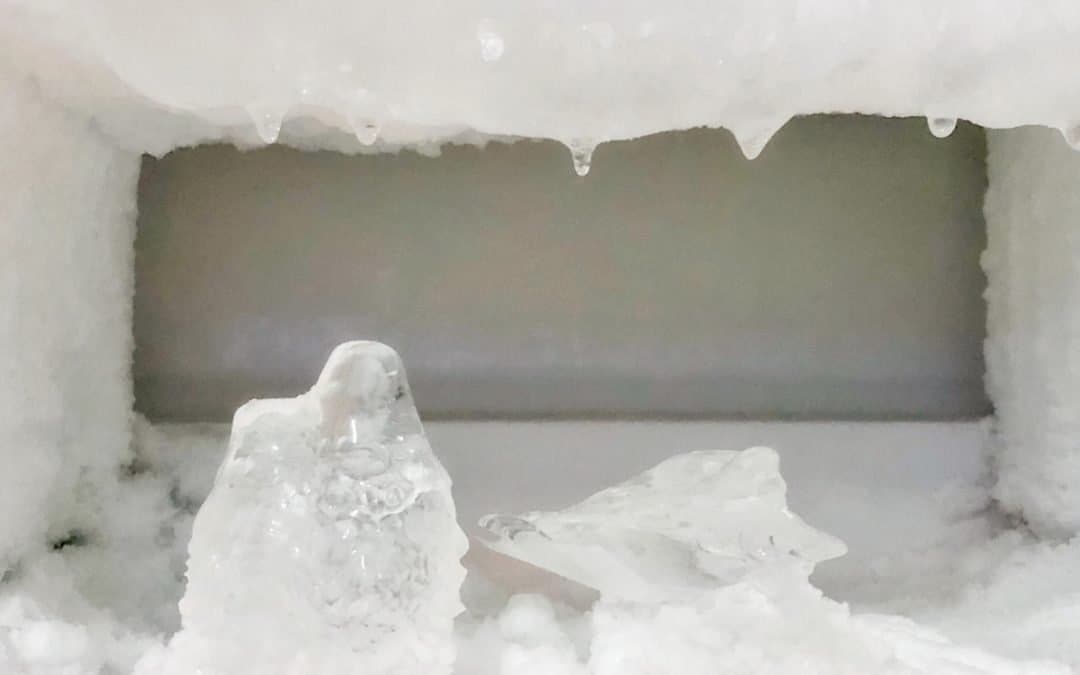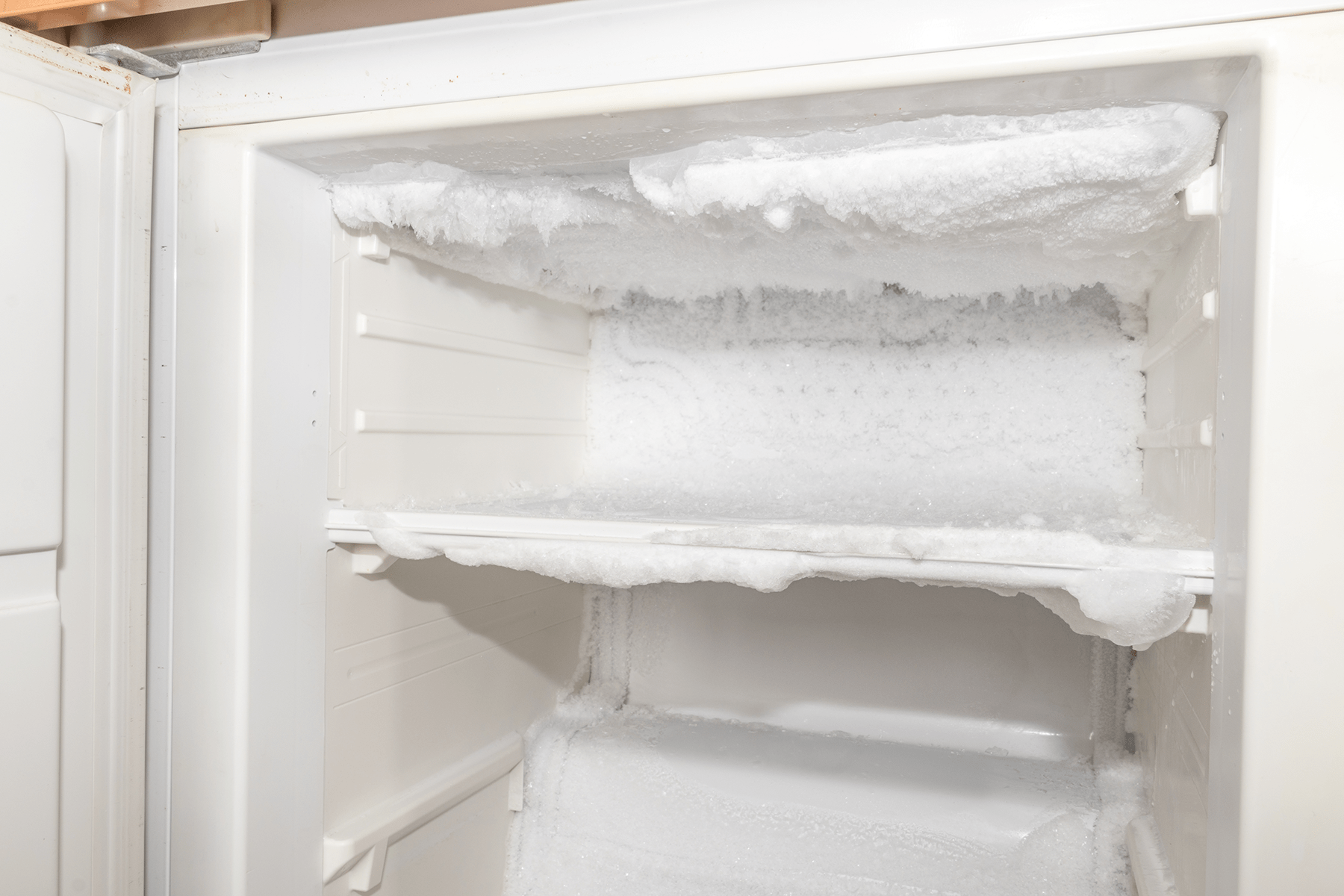Your freezer’s interior covered in frost makes you wonder why this happens. This annoying problem has existed since electric refrigeration began. Frost forms in freezers when warm, moist air gets inside and turns into cold water droplets that freeze on the walls and shelves. The frost that builds up takes away storage space and creates bad odors that lead to freezer-burned food.
Ice builds up in freezer compartments for several reasons. Damaged door seals, opening freezer doors too often, and broken defrost systems cause most problems. Hot foods placed straight into the freezer can make humidity rise by a lot. Your bottom freezer or refrigerator freezer might frost up suddenly because the door didn’t close right, which lets room-temperature air mix with the cold air inside. You need to know why it happens to find solutions that will keep your freezer frost-free and working quickly.

What causes frost in the freezer?
Science explains freezer frost with a simple principle: moisture from warm, humid air freezes the moment it touches cold surfaces. This basic concept helps us understand why freezers frost up and what we can do about it.
How frost forms on evaporator coils
Your freezer’s cooling system centers around evaporator coils that absorb heat from inside. These coils get very cold as refrigerant flows through them. Any moisture that touches these cold surfaces turns to frost right away.
The evaporator coils freeze first since they’re the coldest parts of your freezer. A layer of frost can cover these coils if they don’t defrost properly. This ice layer stops the coils from removing heat well, and your freezer has to work harder while cooling less.
The role of moisture and air leaks
Moisture makes frost possible, and it gets into your freezer several ways:
- Door openings: Warm, humid air rushes in every time you open the door. That’s why opening the door too much leads to frost buildup.
- Air leaks: A bad door seal lets warm air stream into the freezer. Frost around the door area might mean your door gasket isn’t working.
- Hot food: Putting warm items in the freezer adds extra moisture that freezes on the inside surfaces.
A dollar bill test quickly shows if your door seal works. Put the bill halfway in the door and close it. A faulty gasket lets you pull the bill out easily, which means warm air leaks in all the time.
Some freezers have hidden air paths that add to frost problems. Certain models even have holes at the door’s bottom that create a direct path for humid air to enter the freezer through gaps between the door and liner.
Why frost is more common in older models
Older freezers tend to have more frost issues. Their insulation breaks down and creates air leaks that let humid air move inside the walls. This leads to more condensation and higher energy bills.
These older units also have defrost systems that fail more often. Today’s freezers use automatic defrost systems that melt frost before it builds up too much. Older models need manual defrosting or use basic systems with parts that wear out.
Older freezer’s door gaskets often get hard or warped. They can’t seal out warm air properly, so more moisture gets in and turns to frost. Bad gaskets cause most frost problems in old freezers, but they’re easy to fix.
Top reasons your freezer is frosting up
Learning why freezers build up frost will help you find the right solutions. Repair experts have looked at hundreds of freezer problems and found six main reasons for excessive frost.
1. Damaged or loose door seal
Your freezer’s door seal (gasket) protects against warm air getting inside. Regular use can make this rubber seal crack, tear, or come loose. A bad seal lets humid air enter, which turns to frost when it hits cold surfaces.
Here’s how to check your door seal:
- Put a dollar bill between the seal and freezer, then close the door
- Pull the bill out while the door stays closed
- Check this around the entire door
The seal needs replacing if the paper comes out too easily. Dirt can also stop the seal from working properly, so clean it regularly with mild soap and water.
2. Leaving the freezer door open
A door that’s not fully closed will cause frost to build up quickly. This lets warm, moist air mix with the cold air in your freezer. The moisture freezes on surfaces inside once you close the door.
The compressor works harder when the door stays open too long, which could make it overheat or break down. Clear labels on your food containers will help you find things faster and keep the door closed longer.
3. Faulty defrost system components
Modern freezers use three defrost parts that can break:
The defrost timer switches between cooling and defrost modes. Frost builds up on evaporator coils if it gets stuck in cooling mode.
A defrost heater melts frost on the evaporator coils. Frost will keep building up and reduce cooling if this part fails.
The defrost thermostat watches coil temperature and starts the heater. Frost accumulates if a broken thermostat won’t start the defrost cycle.
4. Clogged evaporator drain
Your freezer’s defrost cycle melts frost that should flow through an evaporator drain line. The drain can get clogged or freeze up, trapping water inside.
Water pools below the freezer drawer when the drain is blocked and can freeze into a large ice mass. Ice might form around coolant lines and fans in bad cases, and fan blades could hit the built-up ice.
5. Placing hot food directly inside
Hot food releases moisture inside your freezer. This extra humidity turns to frost on cold surfaces right away.
Let hot leftovers cool to room temperature first. Then put them in the fridge before freezing them. This simple step reduces moisture and frost buildup.
6. Incorrect temperature settings
Wrong temperature settings can make frost build up faster. Your freezer works best at 0°F (-18°C). Setting it too cold leads to frost on interior walls and air vents, which affects temperature sensors and climate control.
Keep your freezer’s air vents clean and clear. Blocked vents create uneven temperatures and moisture that turns to frost. Good organization helps air flow properly around vents and stops these problems before they start.
How to stop your freezer from frosting up
Five simple strategies can help you stop frost from building up in your freezer. These fixes target the root causes of ice buildup and will keep your appliance running at its best.
Check and replace the door gasket
Your freezer’s door gasket is its first line of defense against warm air. A bad gasket lets humid air seep in, which creates perfect conditions for frost. Here’s a quick test to check your seal:
- Put a dollar bill next to the seal and close the freezer door
- Try to pull the bill while keeping the door closed
- The seal needs fixing if the bill comes out easily
Clean the gasket with soap and water to keep it working well. A toothbrush helps remove dirt from tight spots. You’ll need to replace the gasket if you spot tears in the rubber or it won’t seal right. New gaskets cost about $120-$125. That’s cheaper than paying high energy bills from a freezer that runs non-stop.
Organize your freezer for quick access
A well-organized freezer not only makes things easy to find but also cuts down on frost. The less time you spend with the door open, the less moisture gets in.
Group similar items together and use labeled containers so you can spot things quickly. Wire bins and containers with some openings work best as they let air flow through the freezer. Keep your most-used items up front so you can grab them fast.
Cool food before storing
Putting hot food straight into the freezer releases moisture that turns to frost on cold surfaces. This common mistake leads to sudden frost buildup.
Here’s how to cool food the right way before freezing:
- Split large portions into smaller, shallow containers
- Let food cool to room temperature
- Put it in the fridge before moving it to the freezer
You can cool liquids faster in an ice water bath – just stir them now and then. This two-step cooling gets food from 140°F to 70°F in two hours and down to 41°F within four hours. This stops bacteria growth and excess moisture.
Avoid overloading the freezer
A freezer works best when it’s about ⅔ full – not empty or stuffed. This balance keeps good airflow while holding enough cold mass.
Leave gaps between items and near the walls so air can move freely. These spaces stop frost from building up in cold spots and keep the temperature even. When you’re low on food, add some ice packs to fill empty spaces.
Keep the freezer away from heat sources
Where you put your freezer affects how much frost forms. The room temperature should stay between 32°F (0°C) and 110°F (43°C). This helps the compressor work normally.
Keep your freezer away from ovens, radiators, dishwashers, and sunlight. These heat sources make the compressor work harder, which uses more energy and creates more frost. Leave enough space around the unit – 3 inches at the top and sides, 2 inches at the back – so heat can escape.

Manual defrosting: When and how to do it
Your freezer needs manual defrosting from time to time, even with preventive measures. Ice buildup makes your appliance work harder, takes up storage space, and drives up energy costs.
Step-by-step defrosting process
You don’t need special skills to defrost your freezer – just some preparation and patience:
- Prepare and empty the freezer: Unplug your freezer and move frozen food to coolers with ice packs. You can wrap food in newspaper layers with a blanket on top if you’re short on cooler space.
- Set up for water drainage: Put towels around and inside the freezer’s base to soak up melting water. Use a bucket or basin if your model has a drainage hose.
- Allow ice to melt naturally: The safest way is to let ice melt by itself with the door open. You can speed things up by placing hot water bowls inside and replacing them every 15 minutes.
- Clean everything: After the ice melts, clean all interior surfaces with a mild solution. Mix one tablespoon of baking soda with four cups of hot water to clean freezer parts effectively.
- Dry completely before restarting: Make sure everything is dry before you plug the freezer back in and restock.
Safety tips and tools you’ll need
Here’s what you should have ready:
- Towels or plastic liners
- Baking soda to clean
- Plastic scraper (metal tools or sharp objects are a no-go)
- Containers for hot water
Stay away from dangerous methods like using knives to chip ice (you might damage cooling coils), using hairdryers near water (electrical hazard), or closing the freezer door while defrosting.
How often should you defrost manually?
We defrost manually once every 12 months. The ¼-inch rule helps a lot – start defrosting when frost gets ¼ inch thick on freezer walls.
The best time to defrost is when you don’t have much food stored. You might need more frequent defrosting if you live somewhere humid or have a freezer that builds up ice quickly.
When to call a technician
DIY solutions can fix many freezer frosting problems, but some situations need a professional repair technician. You can avoid getting pricey repairs or complete appliance failure by spotting these warning signs early.
Signs of a failed defrost heater or thermostat
The defrost system has significant parts that stop ice from building up. When a defrost heater fails, you’ll see too much frost covering the evaporator coils. This blocks airflow and makes cooling less effective. Models with a single evaporator coil usually keep the freezer cold while the refrigerator section gets warmer.
Your defrost system might be broken if frost keeps building up even after you adjust the temperature settings. A multimeter showing “OL” (open loop) or no continuity through the defrost heater circuit means you need to replace faulty parts.
Persistent ice buildup despite cleaning
Repair experts say that quick ice reformation after repeated manual defrosting points to mechanisms beyond simple fixes. Ice that comes back within days after a complete cleaning suggests problems with internal parts like the evaporator fan or defrost sensors.
The time has come to get a full picture when ice builds up fast even with good door seals and proper loading.
Water leaking from the freezer
Pools of water around your freezer often point to serious problems that need expert help. Your appliance might leak if the drain pan that collects condensation has cracks. On top of that, a blocked drain hole can make water overflow and create puddles.
The combination of water leaks, temperature changes, and frost buildup especially suggests your defrost system isn’t working right.
Unusual noises or smells
Strange freezer sounds—like loud humming, clicking, or grinding—usually mean trouble with the compressor, fan motor, or other vital internal parts. These noises get louder when basic fixes don’t work.
A chemical smell might mean refrigerant is leaking, which needs immediate professional help. The most dangerous sign is an ammonia smell – you should leave your home until a professional can fix it.
Without doubt, quick action on these warning signs and calling a qualified technician can stop small issues from becoming major breakdowns or safety risks.
Suumming all up
Frost buildup in your freezer can be managed with proper care and understanding. The fight against ice starts by learning about the mechanisms behind it. Your freezer’s door seals might be damaged. The doors could be opened too often. The defrost system might have failed. Food storage practices could be wrong. These factors contribute by a lot to this common household problem.
You can save energy and money while making your appliance last longer with some prevention. Check your door seals regularly. Keep freezer contents organized so you can grab things quickly. Let food cool before freezing it. Don’t overload the freezer. On top of that, it helps to keep your freezer away from heat sources so the compressor doesn’t work too hard.
You’ll still need to defrost manually sometimes, even with frost-free models. The quarter-inch rule helps your freezer work at its best. Defrost once a year or when frost gets quarter-inch thick. This prevents high energy use and keeps food fresh.
Some frost problems need professional help. These include failed defrost heaters and stubborn ice buildup that won’t go away after cleaning. Water leaks and strange noises are also red flags. Early detection of these signs stops small issues from becoming major breakdowns.
Learning why frost forms helps you find real solutions instead of fighting symptoms repeatedly. Your freezer can run efficiently and keep food fresh without frost problems when you maintain it properly and act quickly on issues.
Here are some FAQs on why is my freezer frosting up:
How do you fix a freezer that is frosting up?
To address why is my freezer frosting up, first check the door seal for gaps letting warm air in. If you notice why is my refrigerator freezer frosting up all of a sudden, it may indicate a faulty defrost timer or heater. For persistent freezer icing up, manually defrost the unit and reset the temperature to 0°F (-18°C).
How do you stop food from icing up in the freezer?
Prevent ice build up in freezer by wrapping foods tightly in moisture-proof packaging before storing. If wondering why is my bottom freezer frosting up on food specifically, ensure items are completely cooled before freezing. Using airtight containers helps minimize freezer icing up caused by moisture migration.
How to stop a freezer from making ice?
When dealing with why is my freezer frosting up excessively, check that the door closes completely and the seal isn’t damaged. To reduce ice build up in freezer, avoid leaving the door open for extended periods. If why is my refrigerator freezer frosting up persists, the defrost system may need professional servicing.
Why does my freezer keep getting iced up?
Common reasons for why is my freezer frosting up include a damaged door gasket, frequent door openings, or a malfunctioning defrost system. If you notice why is my bottom freezer frosting up specifically, check for proper airflow in that section. Persistent freezer icing up often indicates components like the defrost heater or thermostat need replacement.
What causes frosting in a freezer?
Frosting occurs due to moisture entering when wondering why is my freezer frosting up all of a sudden, often from a faulty seal or frequent door openings. Ice build up in freezer can also result from high humidity foods stored uncovered. When why is my refrigerator freezer frosting up happens, it may signal a defrost cycle interruption.
How to unclog a defrost drain?
If freezer icing up is severe, locate the drain hole at the back and clear it with warm water and a pipe cleaner. For why is my bottom freezer frosting up issues, check if the drain tube is frozen by pouring hot water down it. Preventing ice build up in freezer requires keeping this drain clear of debris.
How to unblock a fridge freezer drain?
When why is my freezer frosting up includes water pooling, use a turkey baster with warm water to flush the drain line. For persistent ice build up in freezer drain areas, a mixture of baking soda and water can dissolve grease clogs. Regular maintenance prevents why is my refrigerator freezer frosting up from drain blockages.
What causes a defrost drain to freeze?
A frozen drain explains why is my freezer frosting up with ice accumulation at the bottom. This freezer icing up occurs when moisture refreezes in the drain line due to poor heating element function. If why is my bottom freezer frosting up includes water leakage, the drain heater may have failed completely.




